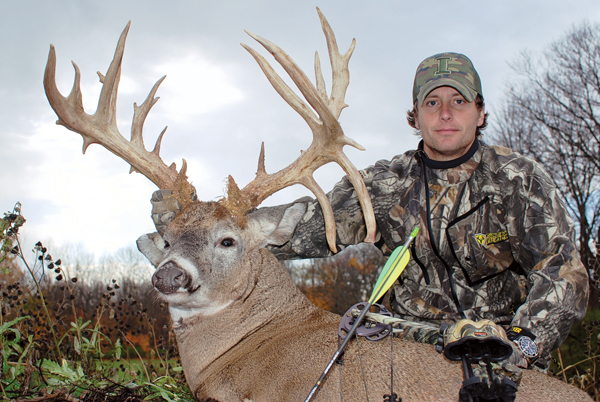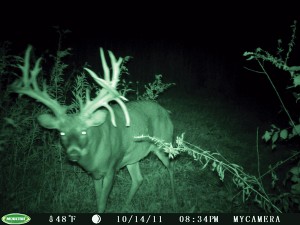 Looking back on it now, I can clearly divide my whitetail hunting career into two “eras”—Before Trail Camera Photo and After Trail Camera Photo. That’s how much my hunting perspective changed after I pulled the memory card from my trail camera on October 16, 2011.
Looking back on it now, I can clearly divide my whitetail hunting career into two “eras”—Before Trail Camera Photo and After Trail Camera Photo. That’s how much my hunting perspective changed after I pulled the memory card from my trail camera on October 16, 2011.
The photo was actually dated October 14, and it clearly showed a whitetail of unbelievable proportions. His rack unquestionably carried the most massive, sweeping frame I had ever seen on a live deer, and his bases were simply unreal. But what held the most importance for me was that the buck was healthy and both sides of his rack were undamaged.
The interesting thing about this deer was that I actually could have shot him on my family’s Ohio farm the previous year, but it was missing something fairly important—the entire right side of his rack.
The buck had walked under my stand in 2010, and instead of picking up my bow, I had grabbed my iPhone to snap of a photo of him. The buck was only carrying his left side, and as deer season was far from over, it seemed odd that he would have shed the right side already.
I remember coming back to the house after that hunt and excitedly telling my father-in-law, Wes, that if this deer carried anything remotely similar to his left antler on his right side, he would easily top 180 inches. I think I even threw out the number 200.
I’ve seen plenty of deer with broken antlers, but I had never seen one broken completely off above the base. At that time in 2010, it was too early in the season for the deer to have started dropping antlers, which had me wondering if this deer had some form of genetic defect that was impeding antler growth on his right side.
As he worked his way around my stand during that hunt in 2010, I fixed my Leica binoculars on his head, trying to determine what had happened to his right main beam, but at 35-40 yards, I couldn’t see enough to make a solid guess. I passed on the buck that year in hopes that he would stick around and grow a matched set of antlers in 2011.
So when I retrieved the memory card from my camera in October 2011, you can imagine how excited I was to find a photo of the buck. From that point on, I knew that if I put in enough time on-stand, it was simply a matter of time and luck for our paths to cross again. I think you probably could have classified my interest in the buck as an obsession. I know my wife would have.
The Sunday following my trail camera discovery, I went to my son’s final flag football game, and then I was off to the farm to hunt. Wes was already in his treestand when I arrived, so I texted him to let him know I was making my way into the woods.
We discussed which stand I should hunt via text message, but I had trouble making a decision. The property has several different stand setups to choose from. Should I hunt the stand 20 yards away from where the trail camera captured the buck’s image? Or should I hunt the stand where I had taken the iPhone picture a year earlier? Or maybe I should hunt one of the other 10 stands on the farm.
I had never debated a stand selection this much in my life, but then again, I had never been pursuing a buck of this caliber. In the end, I settled on the “iPhone stand,” and I climbed in around 3 p.m.
Thirty minutes into the hunt, a young forkhorn appeared about 50 yards in front of me, looking like he was on a mission. An hour after he  cruised through, a group of four does rushed through the area, and I knew something—perhaps the giant non-typical—was pushing them. I stood up and grabbed my bow, ready for action, only to be disappointed when the eager forkhorn cruised through again, hot on the heels of the preceding does.
cruised through, a group of four does rushed through the area, and I knew something—perhaps the giant non-typical—was pushing them. I stood up and grabbed my bow, ready for action, only to be disappointed when the eager forkhorn cruised through again, hot on the heels of the preceding does.
By 6 p.m., things had settled down again, and I was starting to think this hunt would end like so many others, with little activity and no blood. The sun was headed down, and I decided to stand up so that I’d be ready in case the buck did show up.
No sooner had I stood up than I caught movement up the hill from my stand. I didn’t get too excited because I had been seeing so many of the same deer in the hunts leading up to this point. I could see without my binoculars that this deer had a decent rack, and I led myself to believe that it was likely the big 10-pointer I had already passed up twice that season.
I pulled up my binoculars to confirm it was the 10-pointer and immediately spotted a drop tine. I couldn’t believe it! It was the giant non-typical. I laid down a couple of grunts and a doe bleat in his direction, but it didn’t look like he was interested. The buck was just gradually making his way down the hill at his own pace, and it looked like he was on the same trail that the four does had used when they pushed through earlier.
The does had moved into an open area about 30 yards from my stand, and I was desperately hoping the buck would do the same. With my bow in one hand and my Leica rangefinder/binocular in the other, I watched the buck slowly make his way closer. At 38 yards, he hung up, and I readied my bow for a 40-yard shot. There was a tree covering his hind legs and another covering his head and chest. All I had to do was split the uprights.
As I moved my release toward my bow, I could see my hand was shaking slightly. I really could not believe this was about to happen. This was my chance to close the deal. I drew back and tried to get comfortable but couldn’t. My head cover was in the way, and I had to let down and resituate my headgear. Once again, I clipped my release back up to my bow, hand still shaking, and drew back on my bow.
If I let the buck continue walking in the general direction he had chosen, he would likely come into an opening 8 yards closer to my stand, but there was also no guarantee he would take that route. I decided to take the shot I had been given, and I let the arrow fly. I don’t recall the flight path that the arrow took, but the buck mule-kicked like he had been hit. Still, I wasn’t sure if or where I had hit him, and I immediately nocked another arrow in case I got a follow-up opportunity.
The buck ran about 40 yards, then stopped directly in front of me. As I drew my bow, the buck turned to face me, leaving me with only a chest or neck shot. I released another arrow and watched as he turned and bounded 50 or 60 yards away from me. I watched him slow to a walk, believing that I had just missed the opportunity of a lifetime—twice!
I texted Wes to let him know what had just happened, and we decided I would wait in the stand until he arrived after his hunt. That way, I could direct him to the shot locations from the perspective of the treestand.
When Wes arrived, it was completely dark. We started looking for blood or one of my arrows, but it was turning out to be pretty difficult. We walked over to the spot where I had shot the buck the second time, and again we couldn’t find any signs that the buck had been hit.
Obviously, I was beside myself. I had talked about this deer for a year and hunted him for two weeks straight without any breaks until today. The buck finally shows up and I miss him—twice!
“Don’t worry about it,” Wes told me. “You’ll only think about this for the rest of your life…”
We walked to check one final spot—the last place I saw the buck as he had walked away from me after the second shot. We approached the spot carefully, hoping to find the buck lying down, but with it being completely dark and without a flashlight, we would have had to step on the buck to find him.
Up to that point, I hadn’t been able to stop thinking about what I could have done differently. I kept replaying the final moments over and over in my head. I should have let him take a few more steps, I told myself. That way, he would have been completely in the open. The drive home that night was somber—no music, no funny talk shows. When I got home, my daughter, Ashton, sad, “Don’t worry, Dad. You’ll get another chance at him.”
That made me feel a little better, but I knew that the buck had given me an opportunity, and I had wasted it. Needless to say, I couldn’t sleep that night, and in between dozing off, I would wake up and replay the shot over and over.
The next morning, I couldn’t wait to get up and go back out to the farm to look for the buck in the daylight. When I got there, I went to the spot where I had first shot the buck. Once again, I could find no blood or an arrow. It was the same scenario at the second shot location. I couldn’t believe it.
 Finally, I double-checked the spot where I had last seen the buck. About 40 yards into the woods, I could see the monster’s white belly sticking up. I shouted and laughed all the way over to the buck.
Finally, I double-checked the spot where I had last seen the buck. About 40 yards into the woods, I could see the monster’s white belly sticking up. I shouted and laughed all the way over to the buck.
When I got there, the first thing I inspected was actually not his rack. I had studied them so much from the trail camera photo that I knew exactly what they looked like. I was more interested in which one of my arrows had brought him down.
The first shot was a complete pass through and couldn’t have been placed better. I think if I hadn’t shot the deer a second time, he probably would have dropped right in front of me, but when he was hit again, his adrenalin took over and he was able to run again.
It was obvious where the second arrow had impacted because the shaft was still sticking out of his windpipe. If the first shot didn’t kill him, the second one would have.
I was thrilled and incredibly blessed not only to have a history with this buck, but also to be able to finally seal the deal. Last but not least, I’m glad I won’t have to “think about this for the rest of my life.”



















































